 How effective are the chakra meditations of India, Tibet, and China? Which is most effective? Which path is best for spiritual enlightenment? What body energy points correspond to the subtle chakras? Did these traditions arise from a common origin in Tibet? How can we focus on these points to raise our awareness of the subtle body?
How effective are the chakra meditations of India, Tibet, and China? Which is most effective? Which path is best for spiritual enlightenment? What body energy points correspond to the subtle chakras? Did these traditions arise from a common origin in Tibet? How can we focus on these points to raise our awareness of the subtle body?
If you are familiar with either the Yogic or Chinese energy systems, chances are you learned how to use it as a tool to optimize your spiritual body. I practice all three systems every day, so it’s natural that I ask about the striking similarities and critical differences. My innate curiosity somehow requires me to compare them. Which one do YOU prefer? My interest is drawn to the most pure and powerful seed traditions, rather than all the many modern interpretations, which may be watered-down versions of something deeper. In our quest for the roots of all spiritual systems, we have many challenges. Let’s take a look:
Yogic Chakras
Over the past 150 years, the concept of chakras, has seized the Western imagination more than virtually any other aspect of the vast yogic tradition. Yet, just like other practices from Sanskrit sources, the majority of Westerners totally fail to grasp the original concept of chakras and how to use them as a tool for spiritual development. Indian concepts also have been largely “Westernized” after the British colonization starting in the 1600’s, and more strongly after Indians became British subjects in 1858. So at this point it is nearly impossible to find any form of yoga in India not influenced by Euro-American ideas about it. Indeed almost all the teachings on yoga in India today exist in the English language. Surprisingly, most of our limited understanding of chakras comes from a flawed 1918 translation by John Woodroffe, of a text about chakras written in Sanskrit in 1577 by an Indian scholar named Pūrṇānanda Yati. Was it divinely revealed? What was his background?
In the ancient tradition, there’s not just one chakra system, but many! Yes, the theory of the subtle energy centers called cakras (or padmas, ādhāras, lakṣyas, etc.) comes from the tradition of Tantric Yoga which may have originated in Tibet, flourished in India from 600-1300 CE, and is still alive today. After the year 900 CE, every one of the many branches of Tantric Yoga described a different chakra system. Five-chakra systems, six-chakra systems, seven, nine, ten, fifteen, twenty-one, twenty-eight and more chakras were taught, depending on what lineage you’re following. The seven-chakra system that Western yogis know became dominant around the 16th century.
Modern teachings on the chakras tend to describe them in fixed terms, colors, and psychological states. For example ‘the mūlādhāra chakra is at the base of the spine. It has four petals, is the color red, and rules survival, safety, embodiment and grounding’. All these associations of the chakras with psychological states is a modern Western innovation that started with Karl Jung. But the original Sanskrit sources did not teach this. There were myriad other ways to use the chakras, most importantly to function as a template for nyāsa, the installation of mantras and deity energies at specific points of the subtle body. These sacred sounds, your own deity or deities, along with each petal of lotus formed the framework of inner concentration on a chakra.

Tibetan Chakras
The Tibetan Bön tradition has its roots in ancient Shamanism. Bön was founded by the earliest known Buddha, Tonpa Shenrab Miwoche 18,000 years ago. The Bön tradition is still alive and well, in spite of persecution and suppression by Tibetan Buddhists in the 7th to 10th centuries CE. However very little evidence remains of the early practices. The teachings of Padmasambhava, who founded Tibetan Buddhism, bringing Sanskrit and Indian practices to Tibet in the 7th century CE, included the meridians running vertically through the body from the Root to the Crown with braided junctures at each of the chakras. The word chakra means wheel. The spokes on each wheel would indicate the number of channels which connect directly to a chakra. The Tibetan Five-Wheeled Model of the Chakras includes the Root, Navel, Heart, Throat, and Crown. (See top image.)
Tantric Buddhism (or Vajrayana) broke off from the Indian Tantric tradition at a very early stage. Hence they developed a different version of the chakras. Tibetan Buddhism acknowledges four (navel, heart, throat, and head), five, seven, or even ten chakras or “channel wheels”, each having a different number of “spokes” to its Indian Tantric counterpart. The navel chakra for example has sixty-four spokes, the heart chakra eight, the throat sixteen (the only one to agree with the Hindu scheme), and the head or crown chakra thirty-two.
Do the Daoist and Yogic Traditions have a Common Origin in Tibet?
The history begins somewhere between 20,000 and 6,000 years ago, so if you’re channeling the answers, the results will vary depending on where your spaceship lands, and in what century. Presumably China would have been inundated in the biblical flood about 6,500 years ago (along with India, the Middle East and much of Europe). Hence all these traditions might have been newly introduced and evolved after the flood. Perhaps, perhaps all the Eastern traditions developed from a common source in the high mountains of Tibet.
Daoism has always been intimately linked to Chinese medicine and meridians.
However finding the “REAL” or “TRUE” energy gates and pathways in the ancient tradition will carry you far and wide, and will depend on your lineage of teachers, family, or geographic location. China is a big country, and centuries of local evolution of medical and spiritual practices gave rise to huge variations in language, philosophy, names of points, energy gates, and generally total disagreement on terms and methods. Here I have tried to assemble the most ancient, currently accepted, prevalent, and most logical Daoist gates based on traditional texts and my own lineages. I find this particular system to be extremely powerful, and now my preferred base for spiritual practice. But be prepared, as every teacher will have a different version of the Daoist system. Once again, the question is: Which system will carry you to the flowering of your awareness most efficiently and elegantly? Ha ha! After working with both Yogic and Daoist system for decades, this Daoist system is my favorite. Try it and let me know your experience.
Why Is the Daoist System Unknown in the West?
Although the British tried to dominate China in the colonial period, they failed in that effort, and were mainly a trading partner. For that reason, Western grasp of Chinese spiritual practices is perhaps centuries behind our understanding of Indian Yogic traditions. English writings about Daoist practices are rare even now. The tradition is mainly passed from teacher to student in person, with few ancient texts in translation. Chinese is a complex language of innuendos and double meanings, hence translations do not facilitate Western didactic thinking, and interpretations vary widely.
Striking Differences of Yogic and Daoist Systems
The Daoist energetic system is linked to the Extraordinary meridians. This system shows the subtle body flow beginning at the base in Hiuyin or perineum, coming up the back of the body with the Yang Du Mai channel. It goes over the top of the head to the upper gums. The flow goes down the front with the Yin Ren Mai Channel. The Chong Mai Channel (sometimes called the Taichi Pole) in the center of the body connects the top and bottom vertically. Thus The Daoist points are both on the front and back of the body, with a pole in the middle. The energy gathers and coalesces at Xia Dantien, or lower Elixir field near the navel, building kidney Jing and physical health. In most Daoist traditions, the breath begins at the bottom, up the back to the top, and down once again to finish at Huiyin. This is in contrast to the Yogic system, which sometimes begins with an inhale or focus into the Third eye Chakra, flowing down to coalesce in the Heart, moving to the Root, and ultimately spiraling up the central channel to flower at the Crown.
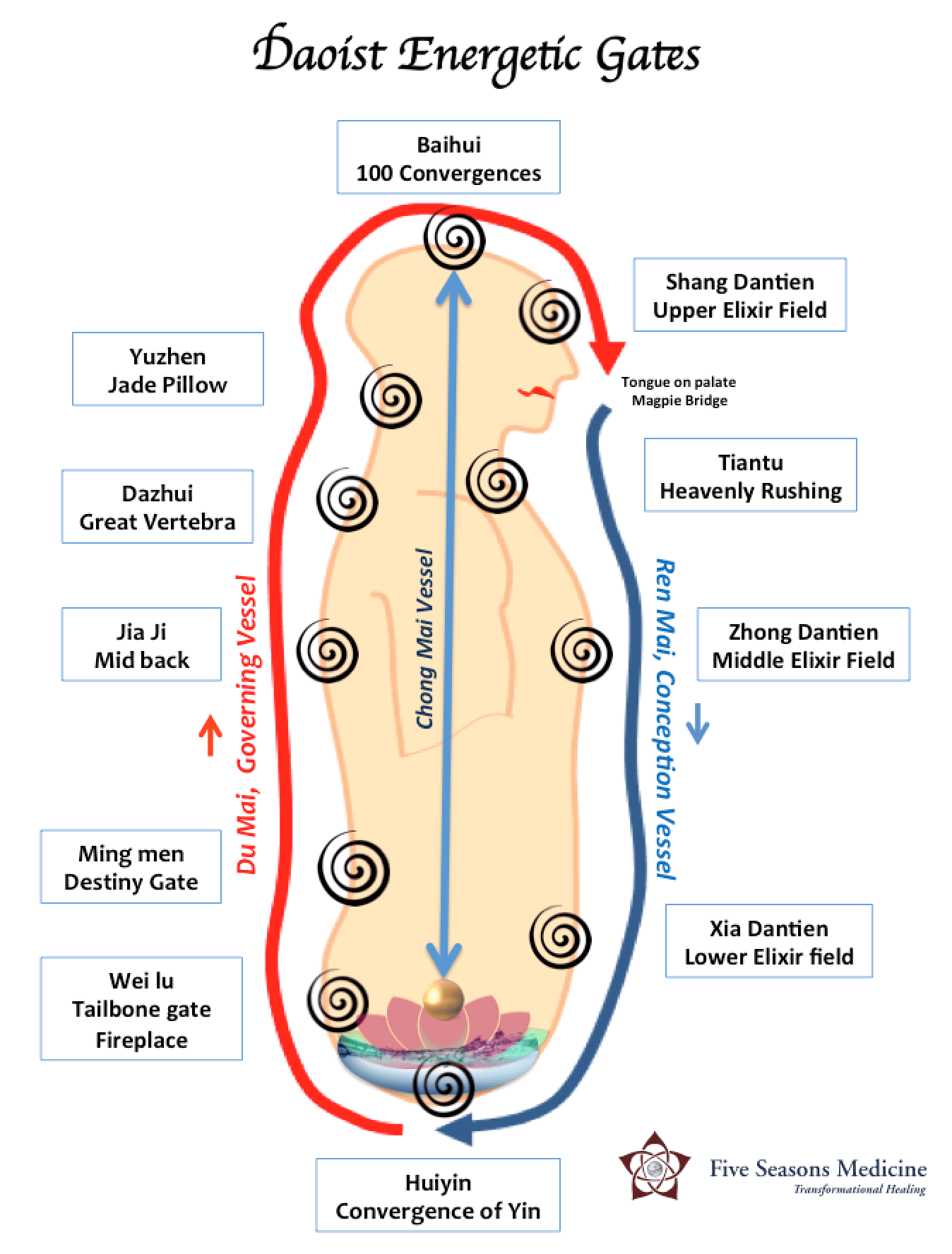
The three primary meridians shown above are part of the Eight Extraordinary meridians which are considered the spiritual, ancestral meridians that form in an embryo, and give rise to the twelve organ meridians. The Du Mai Meridian or Governing Vessel is seen as a central Yang channel. It flows up the back from the base of the pelvis, around the top of the head, ending at the upper lip. The Ren Mai or Conception Vessel is seen as a central Yin channel, flowing down the front from the lower lip to the base of the pelvis. The Chong Mai, or Thrusting Vessel connects the top and bottom of the body vertically up and down from Huiyin to Baihui.
| Gates | English translation | Acupuncture Point |
| Huiyin | Convergence of Yin | DU-1, Ren-1 |
| Wei lu | Tailbone Gate | DU-2 |
| Ming Men | Gate of Life | DU-4 |
| Jia Ji | Mid Back | DU-9 |
| Dazhui | Great Vertebra | DU-14 |
| Yuzhen | Jade Pillow | DU-16 |
| Baihui | 100 Convergences | DU-20 |
| Shang Dantien | Upper Elixir Field | Yin Tang |
| Da Qiao | Magpie Bridge | DU-27 |
| Tiantu | Heavenly rushing | Ren22 |
| Zhong Dantien | Mid Elixir Field | Ren17 |
| Xia Dantien | Lower Elixir Field | Ren-4-5-6 |
\
Yogic Chakras
Chakra means wheel in Sanskrit. In Tantric traditions, chakras are focal points for meditation within the human body, visualized as energy forms such as discs or flowers at those points where several nāḍīs or meridians converge. They are conceptual structures and tend to be located where humans experience emotional and/or spiritual energy.
Chakras are believed to be part of the subtle body, not the physical body, the meeting points of the subtle energy channels called Nadi. Nadi are believed to be pathways in the subtle body through which the life force, or Prana flows. Various scriptural texts and teachings present a different number of chakras. Yes, ancient tantric texts refer to numerous chakras in the body. These seven chakras are considered to be the most important ones.
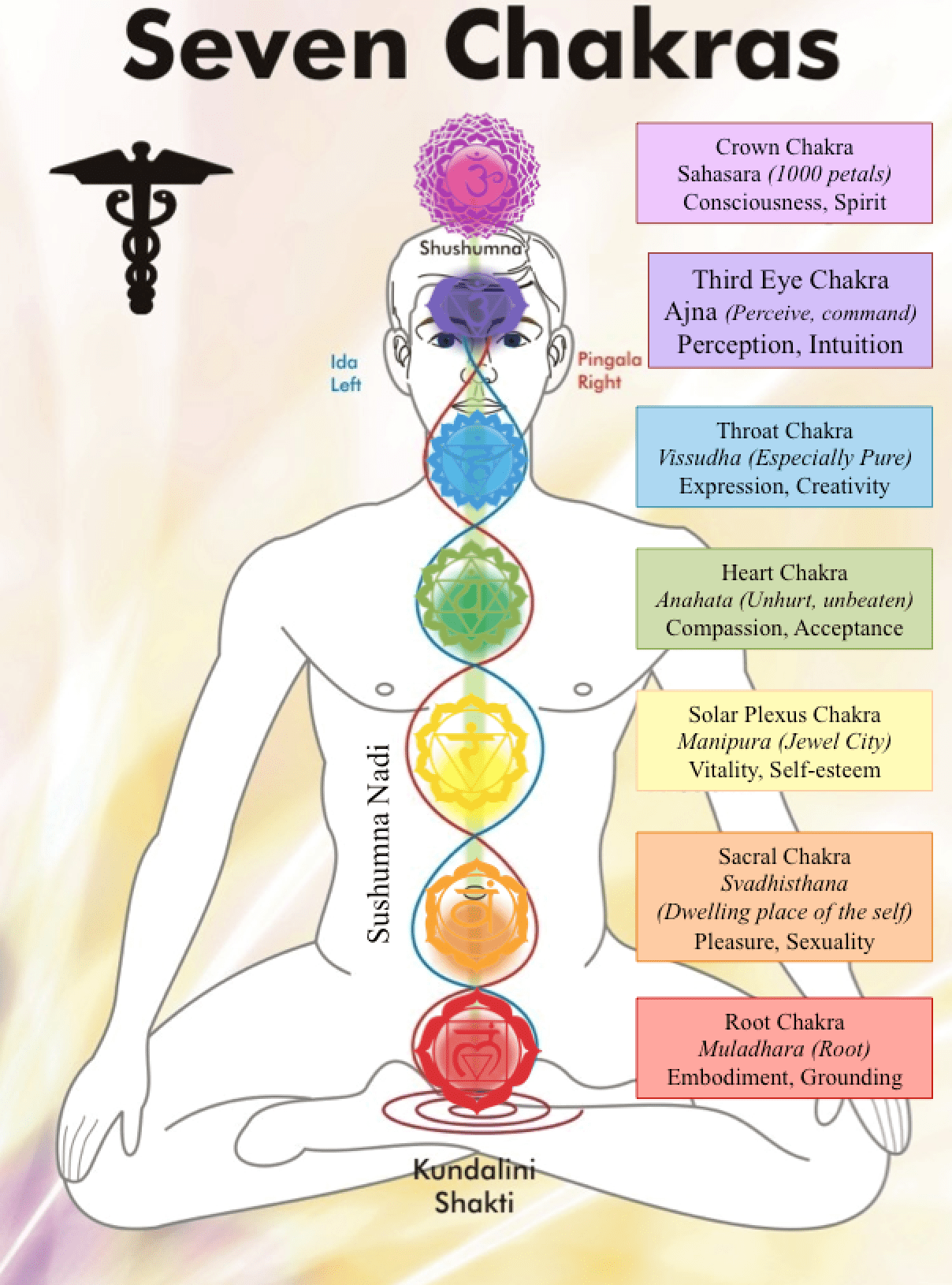
- The Root Chakra, called Muladhara, meaning Root. Symbolizes Embodiment, Grounding. It is depicted with 4 petals. In modern times it is seen as the color red, although its traditional Hindu color is yellow. It is located at the bottom of the pelvic floor near the perineum.
- The Sexual Chakra, or Svadhisthana, meaning the “dwelling place of the self”. In English it is called the sacral chakra or the sexual chakra, associated with pleasure and sexuality. It is depicted with 6 petals. It is pictured as orange, although its traditional Hindu color is light blue. It is located in the lower abdomen, about the two fingers below the navel.
- The Solar Plexus Chakra is called Manipura, meaning “the jewel city”. Associated with vitality and self-esteem, the Solar Plexus chakra is depicted with 10 petals in a yellow color. It is usually said to be at the solar plexus near the base of the ribs, although some practitioners locate it behind the navel. Sometimes, when it is located at the navel, a secondary chakra called Surya (sun) chakra is located at the solar plexus, whose role is to absorb and assimilate Prana from the sun.
- The Heart Chakra is called Anahata, meaning “unhurt, unstruck, and unbeaten”. It and is associated with Love, compassion, and acceptance. It is located in the center of the chest at the level of the heart. It is usually shown with 12 petals in a green color. However the traditional Vedic color for Anahata is smoky green or gray.
- The Throat Chakra is called Vissudha, meaning “Especially pure”. It is associated with expression, creativity, sound, and communication. It is located at the base of the throat. It is depicted as blue in color with 16 petals.
- The Third Eye Chakra is called Ajna, meaning “perceive” or “command” in Sanskrit. It rules perception, intuition, inner knowing. It is depicted with 96 petals in indigo or violet. Although it’s traditional Indian color is luminous blue or white.
- The Crown Chakra is called Sahasrara, meaning “thousand petals”. It is located at the top of the head and symbolizes detachment from illusion, consciousness, spirit. It is depicted with 1000 petals in the color violet or white.
Nadis, Yogic Energy Paths
A Nadi is an energy channel that carries Qi or Prana, also called life force. A river or passageway, there are said to be countless nadis in the human body, from the very subtle to the very gross, carrying energies into, out of, or through the body. Many Asian medical traditions consider energy channels or tubes in the human body, including Chinese medicine. Yoga texts disagree on the number of nadis in the human body, estimated to be anywhere between three and 350,000. We’ll look at the three primary nadis: The Sushumna, Ida, and Pingala.
The Sushumna channel rises up vertically in the center of the body, from Root Muladara to Crown Sahasrara. Two Nadis that ascend and spiral around the Sushumna are the Ida and Pingala. The Ida is said to be on the left, associated with the color white, feminine, cold, and the moon. The Pingala is seen on the right as red, masculine, hot, and corresponding to the Sun.
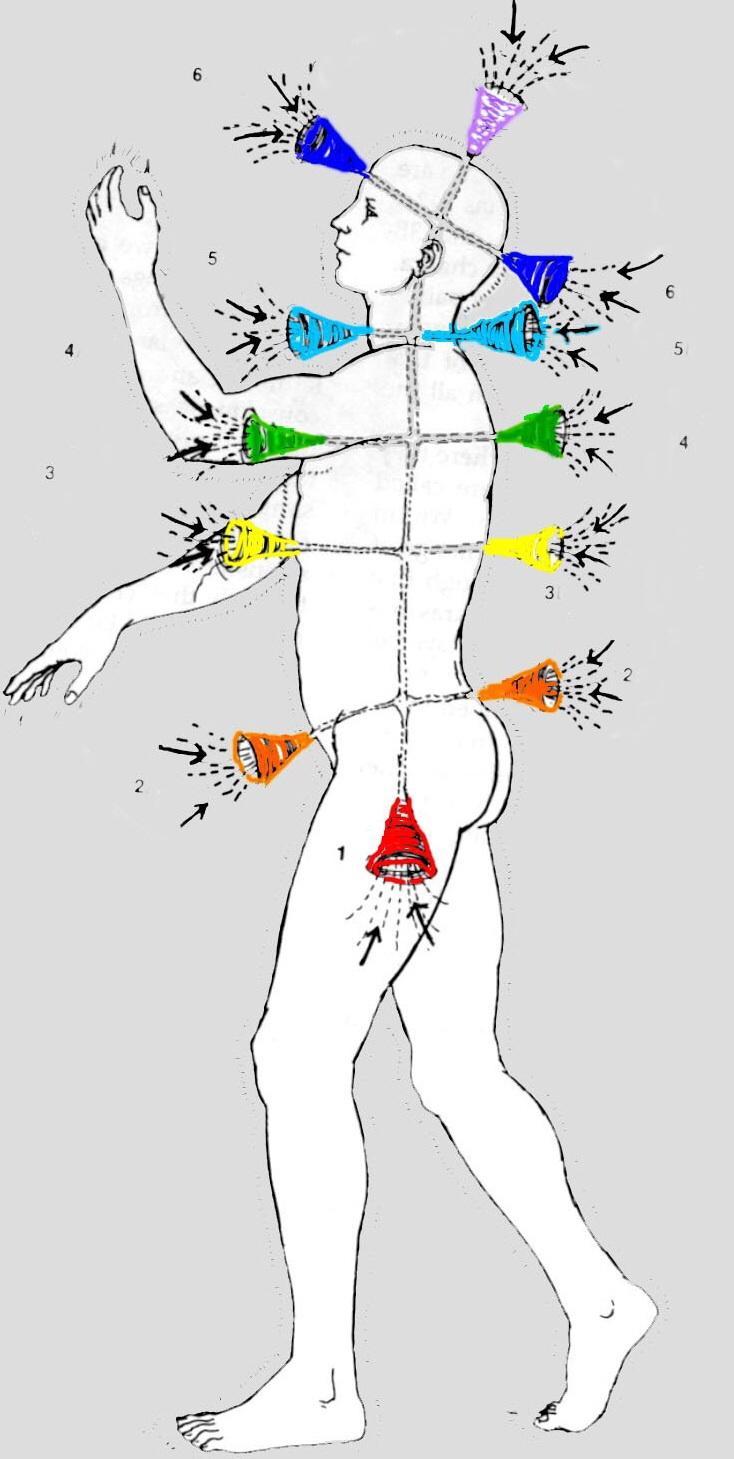
Some practitioners experience the chakras as being active in both the front and the back, originating from the central Subhuman channel, while receiving and receiving and emanating energy in two directions.
For example, Barbara Brennan’s book, Hands of Light: A Guide to Healing Through the Human Energy Field, describes the chakras as transformers that receive and process universal energy, enabling expression and healthy functioning of our consciousness and psycho-physical make-up.
Physical Anatomy Points Associated with Yogic Chakras
Are there physical points in the body that correspond to the chakras? Or are the chakras simply non-physical energy centers? Some medical practitioners see these seven specific points as the specific anatomical reflection of the chakras.
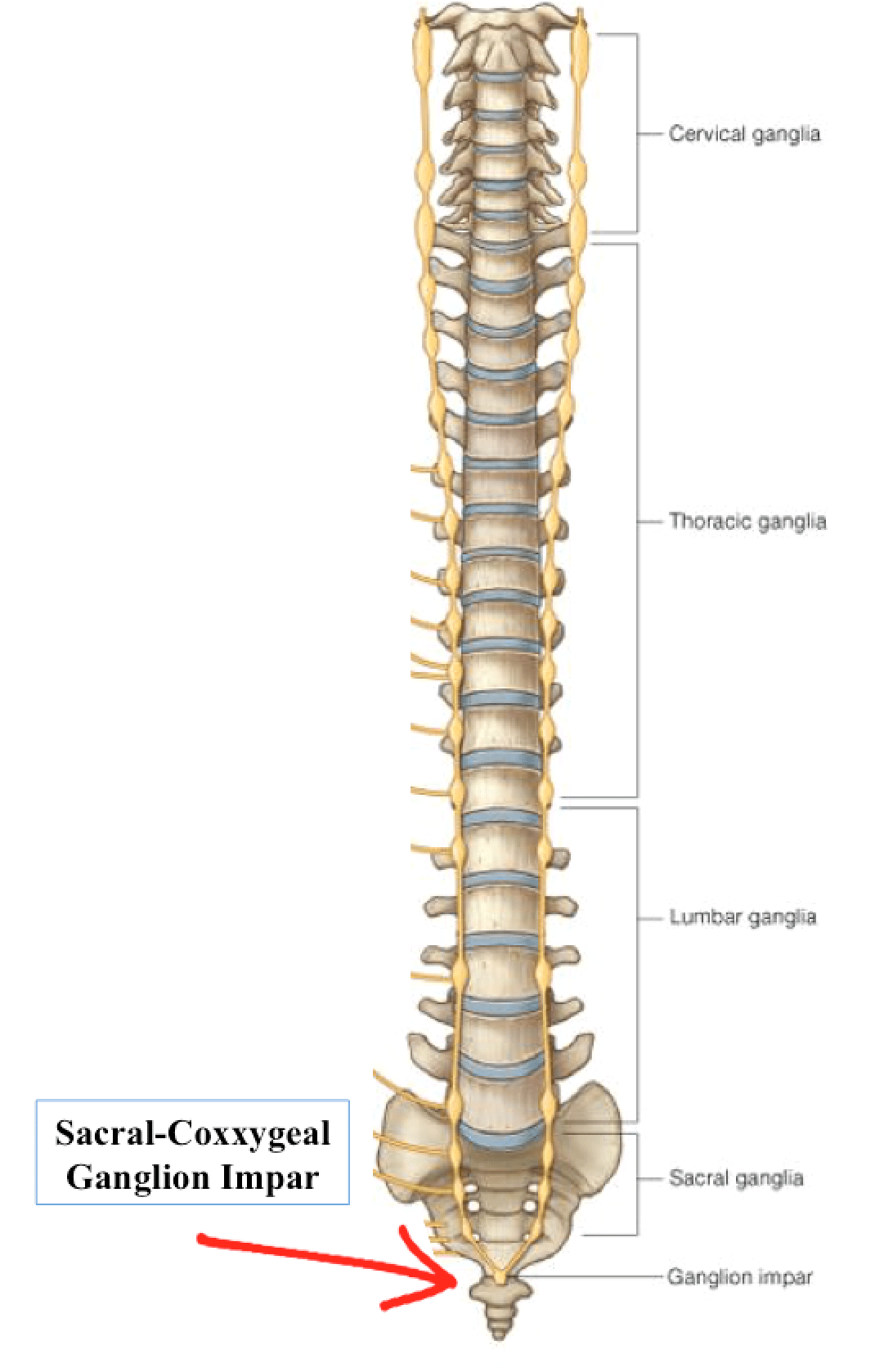
- The Root Chakra is associated with the Sacral-Coccygeal Ganglion of Impar. Sympathetic ganglia are the chains of nerve bundles of the sympathetic nervous system, that deliver information about stress, danger, and the flight or flight response. These sympathetic ganglia run vertically along the spine on both sides, ending with a single point called the Ganglion Impar, or “odd ganglion” in Latin. This is the lowest ganglion at the level of the coccyx, the tip of the chain, and only unpaired ganglion of the sympathetic nerve trunk.
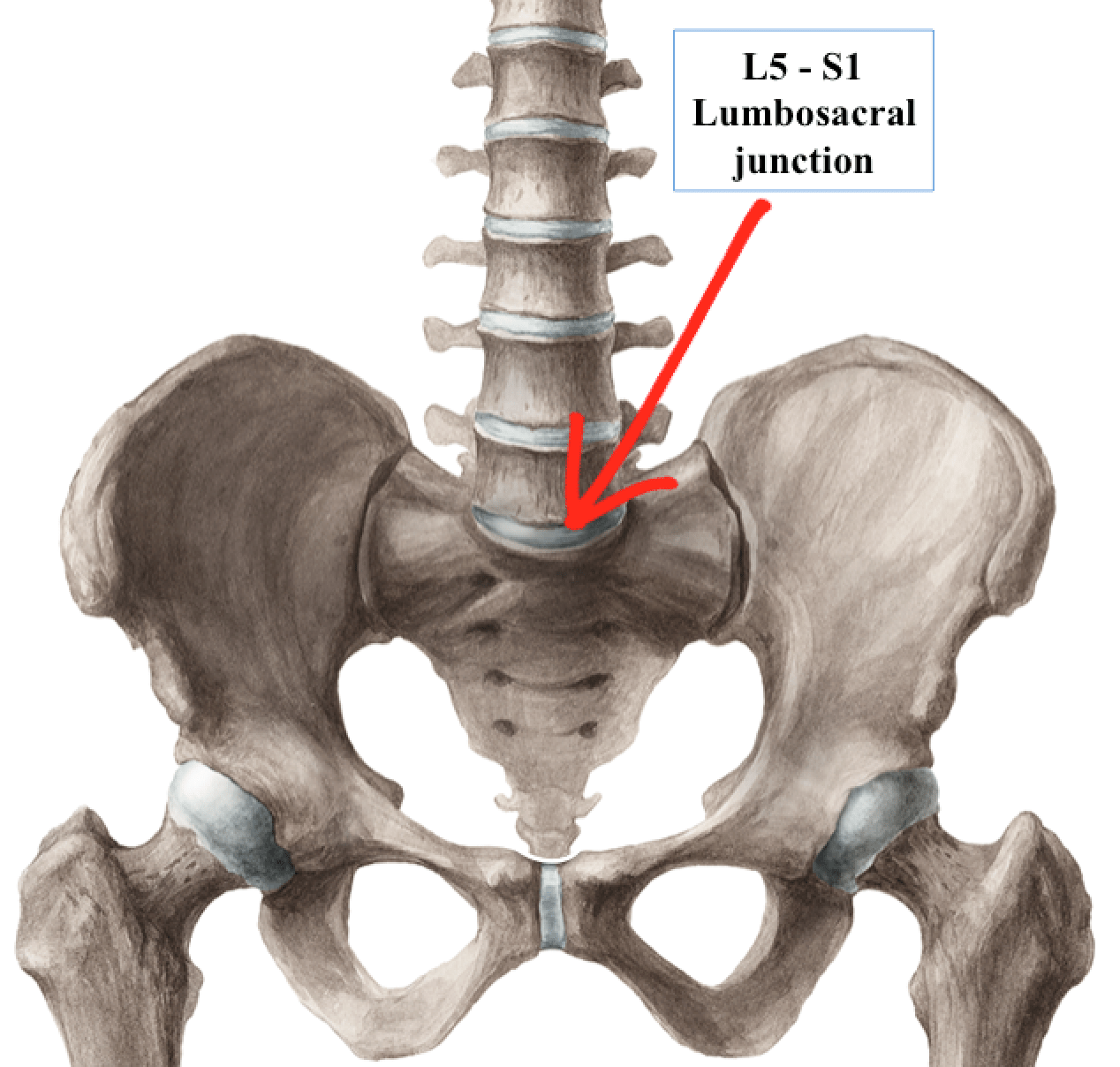 2. The Sacral or Sexual Chakra is said to be located at L5 – S1, the Lumbosacral junction, the meeting point of the lumbar spine and the Sacrum bone.
2. The Sacral or Sexual Chakra is said to be located at L5 – S1, the Lumbosacral junction, the meeting point of the lumbar spine and the Sacrum bone.
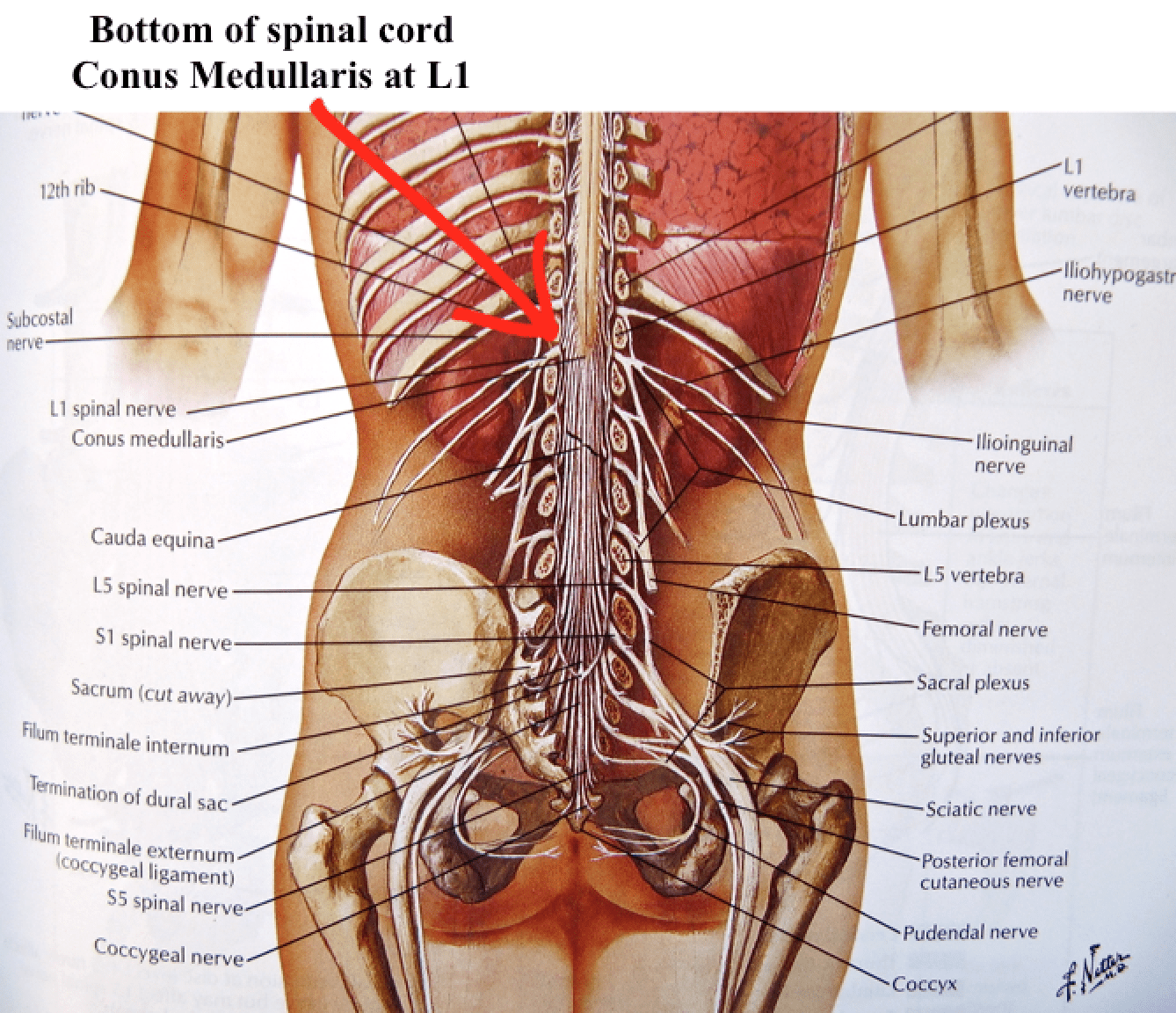
3. The Solar Plexus Chakra
is associated with the L1 vertebra, at the tip of Conus Medullaris (Latin for “medullary cone”), the tapered lower end of the spinal cord. The conus medullaris is the cone-shaped end of the spinal cord, just under the floating ribs, at the level of T12-L1. Below this point, the spinal cord spreads out into becomes many nerve strands called the “cauda equina” or the “horse’s tail”.
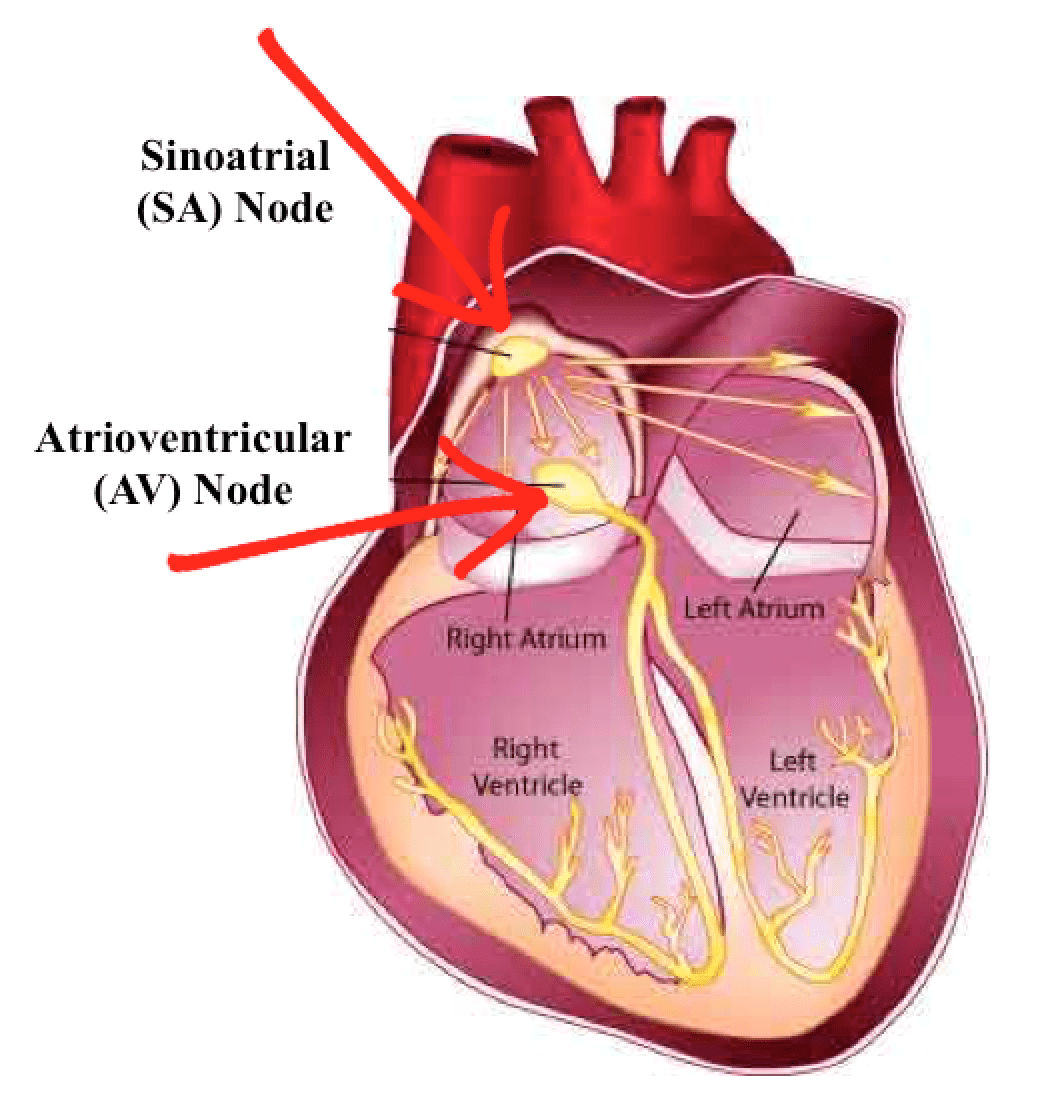
4. The Heart Chakra is associated with the AV Node, or Atrioventricular Node in the upper right atrium of the heart. The atrioventricular AV node is part of the electrical system that stimulates each beat of the heart. It electrically connects the heart’s upper right atrium to the lower right ventricle. Together the Sinoatrial Node and the Atrioventricular Node produce an electrical impulse that travels through the heart’s electrical conduction mechanism, causing it to contract.
5. The Throat Chakra is said to be found in the central fluid within the C5 vertebra.


6. The Third Eye Chakra is associated with the Pineal gland, in the rear center brain, under the corpus collosum.
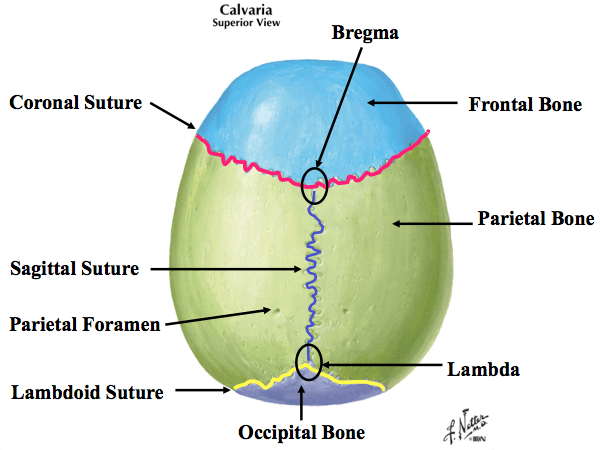
7. The Sahasrara, or Crown Chakra
is located at the top of the skull, or the Bregma, which is the crossing of the coronal and saggital sutures on the cranium. Bregma is from Greek, meaning the “top of the head”.
Conclusion:
No matter which system you choose, these energetic points are essential keys to enhancing your strength, physical, mental, and spiritual well-being. By cultivating the gates or chakras, keeping them alive and clear, you can prevent and heal imbalances or disease. My Qigong and healing practice includes a detailed scan of your energy body, and helps to clear these centers. Come make an appointment to take your next step to total wellness. Contact me: jane (at) fiveseasonsmedicine.com.
“Inhale, and God approaches you. Hold the inhalation, and God remains with you. Exhale, and you approach God. Hold the exhalation, and surrender to God.” Tirumalai Krishnamacharya
Resources:
https://read.84000.co/translation/UT22084-079-011.html, དཔལ་གསང་བ་ཐམས་ཅད་གཅོད་པའི་རྒྱུད་ཀྱི་རྒྱལ་པོ།,
The Glorious King of Tantras That Resolves All Secrets


